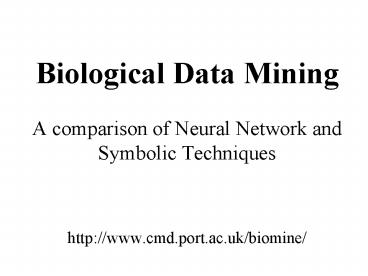Biological Data Mining - PowerPoint PPT Presentation
1 / 11
Title:
Biological Data Mining
Description:
Biological Data Mining. A comparison of Neural ... Dr Shuang Cang (Mar - Sept 2000) Dr Abul Azad (Jan 2001 - ) Dr Antony Browne, London Guildhall University. ... – PowerPoint PPT presentation
Number of Views:331
Avg rating:3.0/5.0
Title: Biological Data Mining
1
Biological Data Mining
- A comparison of Neural Network and Symbolic
Techniques - http//www.cmd.port.ac.uk/biomine/
2
People
- Centre for Molecular Design, University of
Portsmouth - Professor Martyn Ford
- Dr David Whitley
- Dr Shuang Cang (Mar - Sept 2000)
- Dr Abul Azad (Jan 2001 - )
- Dr Antony Browne, London Guildhall University.
- Professor Philip Picton, University College
Northampton.
3
1. Objectives
- The project aims
- to develop and validate techniques for extracting
explicit information from bioinformatic data - to express this information as logical rules and
decision trees - to apply these new procedures to a range of
scientific problems related to bioinformatics and
cheminformatics
4
2. Methods for Extracting Information
- Artificial Neural Networks
- good predictive accuracy
- hard to decipher
- often regarded as black boxes
- Decision Trees
- symbolic rules easier to interpret
- more likely to reveal relationships in the data
- allow behaviour of individual cases to be
explained
5
3. Extracting Decision Trees
- The Trepan procedure (Craven,1996) extracts
decision trees from a neural network and a set of
training cases by recursively partitioning the
input space. - The decision tree is built in a best-first
manner, expanding the tree at nodes where there
is greatest potential for increasing the fidelity
of the tree to the network.
6
4. Splitting Tests
- The splitting tests at the nodes are m-of-n
expressions, e.g. 2-of-x1, x2, x3, where the
xi are Boolean conditions. - Start with a set of candidate tests
- binary tests on each value for nominal features
- binary tests on thresholds for real-valued
features - Use a beam search with a beam width of two.
- Initialize the beam with the candidate test that
maximizes the information gain.
7
5. Splitting Tests (II)
- To each m-of-n test in the beam and each
candidate test, apply two operators - m-of-n1 e.g. 2-of-x1, x2 gt 2-of-x1, x2, x3
- m1-of-n1 e.g. 2-of-x1, x2 gt 3-of-x1, x2,
x3 - Admit new tests to the beam if they increase the
information gain and are significantly different
(chi-squared) from existing tests.
8
6. Example Substance P Binding to NK1 Receptors
- Substance P is a neuropeptide with amino acid
sequence - H-Arg-Pro-Lys-Pro-Gln-Gln-Phe-Phe-Gly-Leu-Met-NH2
- Wang et al. (1993) used the multipin technique to
synthesize 512 29 stereoisomers generated by
systematic replacement of L- by D-amino acids at
9 positions, and measured binding potencies to
central NK1 receptors. - The objective was to identify the positions at
which stereo-chemistry affects binding strength.
9
7. Application of Trepan
- A series of networks with 991 architectures
were trained using 90 of the data as a training
set. - For each network a decision tree was grown using
Trepan. - The positions identified agree with the FIRM
(Formal Inference-based Recursive Modelling)
analysis of Young and Hawkins (1999).
10
8. A Typical Trepan Tree
11
9. Future Work
- Complete the implementation of the Trepan
algorithm. - model the distribution of the input data and
generate from this a set of query instances that
are classified using the network and used as
additional training cases during extraction of
the tree. - Extend the algorithm to enable the extraction of
regression trees. - Provide a Bayesian formulation for the decision
tree extraction algorithm. - Compare the performance of these algorithms with
existing symbolic data mining techniques
(ID3/C5). - Apply Trepan to ligand-receptor binding problems.

